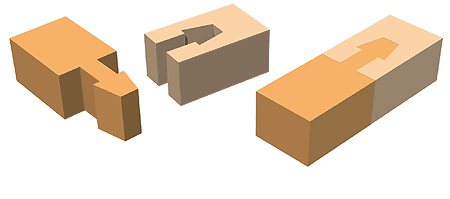|
||
 |
||

(C)2001 Japanese Architecture and Art Net Users System. No reproduction or republication without written permission.
掲載のテキスト・写真・イラストなど、全てのコンテンツの無断複製・転載を禁じます。
|
||||||
| kamatsugi 鎌継 | ||||||
| KEY WORD : architecture / joints | ||||||
| A
gooseneck tenon and mortise joint. The mortise is cut into one section,
and the tenon, with head and neck a single member, is cut into the other.
The neck of the tenon is roughly square or rectangular and varies in length
according to need. Kamatsugi were used as early as the 7c. By the
medieval period, the head was tapered and resembled a blunted
arrow. A variation resembling a double gooseneck with heads at each end
of the tenon is set into the mortise of the same shape. Usually used to
connect two beams. The joint is called *chigiritsugi
千切継. |
||||||
 |
||||||
| REFERENCES: | ||||||
| *koshikake kamatsugi 腰掛鎌継, *mechigaihozotsuki kamatsugi 目違ほぞ付鎌継 | ||||||
| EXTERNAL LINKS: | ||||||
| NOTES: | ||||||
(C)2001 Japanese Architecture and Art Net Users System. No reproduction or republication without written permission. 掲載のテキスト・写真・イラストなど、全てのコンテンツの無断複製・転載を禁じます。 |
||||||